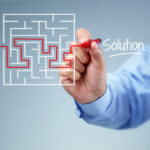
When customers ask for new products or features, should you jump to fill the request? These situations can help you deepen your relationship with your customer. On the other hand, you could also end up wasting time and resources creating a new offering that they’re not willing to pay more for and that no other customer needs.
For example, let’s say you’re a manufacturer and one of your customers asks for a new kind of lubricant that can withstand much higher operating temperatures than the current lubricant they’re buying from you. The first thing you should do is ask if such an offering fits into your sweet spot. A sweet spot is the intersection of two things:
- What your customer SHOULD want.
- What you’re uniquely qualified to provide.
What Should the Customer Want?
Your first consideration should be about what the customer should want. In other words, you need to ask them why they want a lubricant that can withstand higher operating temperatures. It’s very possible that they’re asking for a product that in theory sounds good but in reality ends up not saving them any money — or even ends up costing them money.
For example, maybe they don’t realize that this type of lubricant has a shorter useful life. Or, perhaps your cost for creating this new type of lubricant will force you to raise your price by 20 percent and they wouldn’t be willing to pay.
What Are You Uniquely Qualified to Provide?
The second consideration is what you’re uniquely qualified to provide. Stop and ask your team internally, “Why us? Why are we going to be better than anyone else at producing this new lubricant?”
If someone can do it better than you can, then customers are going to buy it from that other company and not you. Or worse, they’re already using a high-temperature lubricant from your competitor and want you to match that specification in hopes of creating a price war.
Why Engineering Shouldn’t Drive Product Development
We often see these kinds of problems in companies where the engineering team drives product development instead of the marketing team. In these cases, companies can waste lots of money and time building a better mousetrap without considering who might want that mousetrap, why they might want it, and what they’ll be willing to pay for it.
A great example is Betamax versus VHS tapes. Technologically speaking, Betamax was superior. It offered better screen resolution, sound quality, and color quality compared to VHS. But you couldn’t put a full two-hour movie on a Betamax tape. As you can see, just a single feature (in this case, storage capacity) can dictate total success or failure in a market. If Betamax had been driven by marketing instead of engineering, they might have asked the two key questions to find their sweet spot and avoided disaster.
Why Marketing Needs to Drive Product Development
Marketing-driven organizations (which is what you should strive to be) always look for their sweet spot by doing two things. One, they take time to evaluate the request against the customer’s economic needs to see if this is something they should want. Two, they look to see if there are other potential customers in the market that have similar needs.
Salesforce.com is a great example of a marketing-driven company that focused on what customers should want. They essentially created the now ubiquitous cloud-based CRM market by convincing customers to opt for a cloud-based solution rather than a client-server solution (and its high IT infrastructure costs).
The next time a customer comes to you with a request for a new product or feature, first gain a deeper understanding of what they’re trying to do. Talk to other customers, watch how they operate, and ask yourself what you would do if you were in their role. Then make sure that your company is in the best position to meet those needs in a sustainable fashion.
If you do this, you’ll greatly increase the probability that you are creating a profitable and sustainable offering instead of wasting time and money.

[Image via Flickr / Mish Sukharev]














